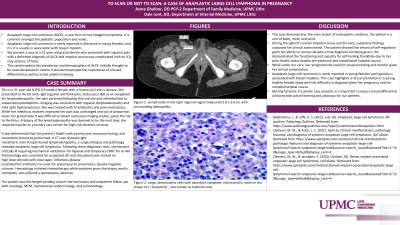Medical Education
TO SCAN OR NOT TO SCAN: A CASE OF ANAPLASTIC LARGE CELL LYMPHOMA IN PREGNANCY
Friday, March 31, 2023
12:00 PM East Coast USA Time


Asma Ghafoor, DO
UPMC Lititz
lititz, Pennsylvania, United States
Presenting Author(s)
Introduction: A 31-year-old gravid female presented to the hospital with inguinal pain after several ED visits and was admitted for pain management, her hospital course was complicated with an ICU stay and loss of fetus. Her definitive diagnosis was anaplastic large cell carcinoma (ALCK), a rare form of non-Hodgkin lymphoma; while her pain was thought to be musculoskeletal this case demonstrates the importance of a broad differential and active listening.
Case Study: This is a 31-year-old G1P0 (19 weeks) female. She presented to the ED with right inguinal and flank pain, status post I&D as an outpatient for lymphadenopathy. Her pain persisted following this and she was admitted due to suspected pyelonephritis. Imaging was consistent with inguinal lymphadenopathy and mild right hydronephrosis. She was treated with IV antibiotics and pain medications. While her infectious markers improved her pain was unchanged and out of proportion. Given her gravid state it was difficult to obtain necessary imaging studies, given the risk to the fetus. A biopsy of the lymphadenopathy was deemed to be the next step; she required transfer to a tertiary care center for high-risk obstetric services.
A CT scan showed right mesenteric and retroperitoneal lymphadenopathy, a surgical biopsy and pathology revealed anaplastic large cell lymphoma. Following these diagnostic tests, she became critically ill requiring mechanical ventilation for hypoxia and temporary CRRT for an AKI. Pulmonology was consulted for suspected ILD and the patient was started on high dose steroids with slow taper. Infectious disease escalated her antibiotics to cover for pneumocystis pneumonia, despite negative cultures. Hematology initiated chemotherapy while inpatient given the biopsy results. Ultimately, she suffered a spontaneous abortion.
Discussion: This case demonstrates the main tenant of osteopathic medicine, the patient is a unit of body, mind, and spirit. During the patient’s earlier hospital course and ED visits, subjective findings outpaced her clinical assessments. The patient showed the tenant of self-regulation given her ability to recover despite a final diagnosis not being given; she demonstrated the functioning and capacity for self-healing thankfully due to her prior health status despite the extensive and complicated hospital course.
While under our care, we recognized the need for invasive testing and transfer given her clinical presentation. Anaplastic large cell carcinoma is rarely reported in young females and typically is associated with breast implants. Moving forward, if a similar case presents it is important to keep a broad differential and prioritize active listening and advocacy for our patients.
Case Study: This is a 31-year-old G1P0 (19 weeks) female. She presented to the ED with right inguinal and flank pain, status post I&D as an outpatient for lymphadenopathy. Her pain persisted following this and she was admitted due to suspected pyelonephritis. Imaging was consistent with inguinal lymphadenopathy and mild right hydronephrosis. She was treated with IV antibiotics and pain medications. While her infectious markers improved her pain was unchanged and out of proportion. Given her gravid state it was difficult to obtain necessary imaging studies, given the risk to the fetus. A biopsy of the lymphadenopathy was deemed to be the next step; she required transfer to a tertiary care center for high-risk obstetric services.
A CT scan showed right mesenteric and retroperitoneal lymphadenopathy, a surgical biopsy and pathology revealed anaplastic large cell lymphoma. Following these diagnostic tests, she became critically ill requiring mechanical ventilation for hypoxia and temporary CRRT for an AKI. Pulmonology was consulted for suspected ILD and the patient was started on high dose steroids with slow taper. Infectious disease escalated her antibiotics to cover for pneumocystis pneumonia, despite negative cultures. Hematology initiated chemotherapy while inpatient given the biopsy results. Ultimately, she suffered a spontaneous abortion.
Discussion: This case demonstrates the main tenant of osteopathic medicine, the patient is a unit of body, mind, and spirit. During the patient’s earlier hospital course and ED visits, subjective findings outpaced her clinical assessments. The patient showed the tenant of self-regulation given her ability to recover despite a final diagnosis not being given; she demonstrated the functioning and capacity for self-healing thankfully due to her prior health status despite the extensive and complicated hospital course.
While under our care, we recognized the need for invasive testing and transfer given her clinical presentation. Anaplastic large cell carcinoma is rarely reported in young females and typically is associated with breast implants. Moving forward, if a similar case presents it is important to keep a broad differential and prioritize active listening and advocacy for our patients.
